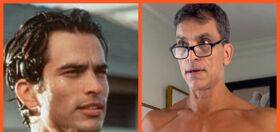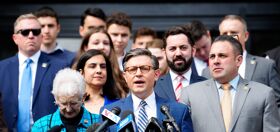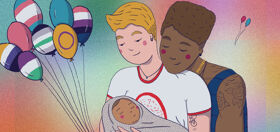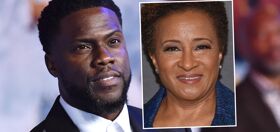 To honor Transgender Awareness Week, Queerty contributor Gwen Smith, founder of Transgender Day of Remembrance, talked to trans leaders who are making a difference in the long road to equality in difficult times.
To honor Transgender Awareness Week, Queerty contributor Gwen Smith, founder of Transgender Day of Remembrance, talked to trans leaders who are making a difference in the long road to equality in difficult times.
S. Bear Bergman is the author of six books, three of which were published by Flamingo Rampant, a children’s book company he founded. He has twice been a Lambda Literary Awards Finalist, once with his collection of essays, “The Nearest Exit May Be Behind You,” and once with a children’s book, “The Adventures of Tulip, Birthday Wish Fairy,” illustrated by Suzy Malik. He also co-edited the book “Gender Outlaws: The Next Generation” with the great Kate Bornstein.
When the prolific author and publisher is not tied to his keypad, he travels to universities and festivals, telling stories and sharing his combination of wit and insight. When not on the road, Bergman lives in Toronto, Ontario, with J Wallace Skelton and their three children.
Queerty sat down with Bear to talk about the ideas behind his work
How about we take this to the next level?
Our newsletter is like a refreshing cocktail (or mocktail) of LGBTQ+ entertainment and pop culture, served up with a side of eye-candy.
What would you like people to know most about S. Bear Bergman?
I do a lot of work around issues of the intersection between gender identity and sexuality, and between those things and culture. Throwing it back a long way, I was one of the founding members of the Gay-Straight Alliance, which is now as you know, a global movement, which is weird, but nice. Also, more recently the founder of Flamingo Rampant, which is a picture book press that makes celebratory feminist, culturally diverse, LGBTQ positive children’s books. I’m a father of three children. Yeah, I am all of those things.
I’m coming up on year twenty-eight as a queer activist, starting back when we started the Gay-Straight Alliance and I started working on the Massachusetts safe schools initiative in 1991, which was the first-ever statewide commission devoted to protecting gay and lesbian students. The mandate has expanded over time to include, you know, all queer and trans kids. I’ve been at it for a long time–since I was 17 years old.
Tell me something that, that I don’t know, that might surprise people to know about you.
It’s difficult for a person that has published three books of essays about my experience and identity to think about something that most people wouldn’t.
I think something that most people wouldn’t know is that I continue to work in the radical end of queer politics through meeting people in their emotional state, instead of the political one. Linking people into my experience by starting their own experience — or their sense of wonder, exclusion, ostracism, or whatever emotional hook I can find, and then building on that to try and help them gain knowledge on how to treat LGBT people. When I say I’m a cultural worker, people imagine a lot of yelling. In fact, I am mostly the opposite. I’m much more likely to try and get people in there in their sweet, soft feelings place.
What drove you to stay creating books for kids and families?

The intersection of a couple of different things. One of them was that I had children of my own and wanted to read some books that showed our family, and our community, as part of a way to sort of validate and normalize their experience.
Dr. Regina Sims Bishop from the Ohio State University talks about the fact that children’s picture books can function as a mirror, in which kids can see their own experience, and also a window, where they can see experiences unlike theirs. What I noticed about so many picture books that dealt with LGBTQ kids and families is that the mostly fell into two categories. One was fairly wide, kind of like, Some people have two dads, and that’s not terrible. The end. And that’s very nice, but also that’s not very interesting to children. And the other ones were books that focused mostly on gay or trans bias. The kids in these books, their primary “problem” is that they are gender independent or they had gay or trans parents.
I would read these books to my [first] kid, and after a while, I got some feedback. These books I could find at the time featured white kids, and everyone was also able-bodied, and the same size, etc. I could not find books that combined communities at all.
Between the one and the other, I really started feeling we needed better books for kids from LGBTQQ families so they could have a better experience, and books that I wish I could have had as a child, I also wanted kids who had no queer virtual spaces anywhere in their real-life to be able to understand that any kid could be the.
The state of children’s books when I started Flamingo Rampant as a project in 2011 was sort of underwhelming. Many of the books were really grim, all of them were really white, with just a couple of exceptions, and I just thought, Oh G-d, think I can do better.
I started publishing in an effort to make beautiful books with fun stories that kids could enjoy no matter what their own sexual orientation or gender identity or family. Books about faith, and fairies, and sports, and pirates. Books where kids are the primary problem solvers, and books where kids in families who have been previously erased could be beautifully represented.
So that became kind of the first guiding principle of Flamingo Rampant, with stories where that were celebratory, where the kids were loved. Then there was this immediate sort of the second principle that Flamingo Rampant had to center kids and families of color. We have stuck to those twin guiding mandates as we have now published 22 children’s books.
What sort of reactions have you gotten?
Things across the spectrum from completely delightful to absolutely awful. The delightful ones have really been people who have responded to the book in the way that I’d hoped: Parents who really been looking for books like that and not been able to find — but also from parents who bought them for one reason, and then were surprised and delighted to discover that other things were also happening in the stories. I got an email from a woman who said, I ordered these books because my middle child is a gender independent kid, and I wanted them to have some books that reflected that, but also when they arrived to discover that several of the books featured kids who use wheelchairs, and we’ve never seen books that had kids in wheelchairs where that was part of them.
Related: Monica Roberts on the key to her awesome trans advocacy: I’m an equal opportunity offender!
One of our primary values is not presenting any parts of a child’s or family’s identity as a problem. That is something that adult parents, teachers, librarians have really appreciated and valued about Flamingo Rampant. We’re gotten beautiful messages from kids and parents on that.
I also heard from a woman who wrote to say, “I’m from the Midwest, I didn’t know any gay at all growing up. When I got to college. I met gay people and I had a hard time. I had to do a lot of work to get over my childhood programming about that. Now I have kids and I live in a similar place in the Midwest where there really are not out queer people or out trans people in my kid’s world, and so your books are great because it allows me to expand their understanding of what families can be like, and identity can look like.”
There are spaces in the existing children’s literature that we can fill. We published, as far as we know, the first-ever two-spirit children’s book. We published the first Muslim children’s books featuring two gay dads. We’ve really tried to address places in children’s literature where there currently isn’t anything.
For sure, there’s been a negative reaction. There are people who’ve challenged our books in school, people who really don’t want the work we do to exist in their kid’s school community. I really kind of don’t care about those people. I’m really not in it for them.
I should say that is kind of the third piece that really came into play was the problem of violence against LGBTQ, particularly against trans women of color.
Trans Day of Remembrance has had a big impact. After these murders, there’s kind of nothing to do but send money and pray — and I do those things. So remembering, it is important. But I couldn’t stop thinking, What if we could work on prevention. Where is there an opportunity to intervene early enough that violence does not happen in the first place?
The answer that I came back with was, Well, you keep bringing it up. You know, if people read children’s books when they were little that show queer and trans people being just like everyone else it would make a big difference. Then maybe when they’re 25 and they meet actual queer and trans people in the world, they will be less likely to respond with violence. That’s really my dream that we can reach a place where, you know, people don’t find it upsetting and alarming that LGBTQ people simply exist.
This is Transgender Awareness Week. What’s next for the movement?
My biggest thing, to be honest, like if there’s one piece, is that we’re not new. You know, trans and non-binary people are not new in the world.
If you look across the world back in time, so many indigenous societies had positive to neutral words and positive to neutral social roles for people who today we would understand as trans or non-binary or queer.
Colonization happens, and it was a violent erasure, not only of people but also of culture. The religious and cultural laws of the colonizer forces could not allow people to be gay, or lesbian, or bi, or queer. And so not only were those people violently forced to either become normative or be killed, but it also worked really hard to erase the words for us, the social roles for us, the knowledge that we existed.
The visual I like to offer to people is this: Imagine a field of wildflowers and then imagine that that field gets paved over and people are like, “Okay, this is now a parking lot.” That’s colonization. Now it’s a parking lot. Okay. But you know, anyone who’s ever had any experience with paving, he knows you have to keep it up. You have to keep sealing it against the weather. You have to keep re-blacktopping over it to keep it working right. And when you eventually stopped it starts to crack up and then the wind gets in and then the weather gets in and then you get, you know, those first few flowers coming up through the cracks. One bright pansy pops up somewhere and you know, those cracks allow more water in and more light in and pretty soon it’s clear to everyone that it wasn’t always a parking lot, but there’s always been a meadow under there.
What I feel like we’re actually seeing now, um, is the natural order reasserting itself. When people say, “Oh, nobody ever talked about trans, there weren’t any trans people when I was young or, you know, nobody ever was trans when I was a kid.” That’s A, not really true. And B, it’s not that no one was trans. It’s that we were still working on the project of healing from colonization. Now that the repressive forces of colonization are not keeping us from the knowledge and experience of trans and non-binary people, lots more people are able to come out and be present in the world. If there’s one thing, it’s that we’re not new in the world at all. We have always been here — and I can prove it right? I can prove it in law, in poetry, in the artwork, all kinds of things. I feel like it’s useful for everyone to know that this isn’t a new thing and we’re not like a new concept. We’ve always seen that in the world already.
How do you picture the future for the transgender community — and related to this, what would you like to be remembered as a part of the community? What sort of legacy do you see for yourself?
What legacy do I see for myself? What an interesting question, and I’m not sure I know the answer. I hope that I will have helped people to understand LGBTQ people’s experience in a way that’s more nuanced than what has really been available through mainstream popular media.
At Flamingo Rampant, we talk a lot about the landscape of the imagination, but part of our work is to populate the landscape of people’s imagination. When you’re a kid you sort of only are aware of what you’ve had introduced to you. I like the idea that we are adding more features to the landscape of people’s imagination. Young people, certainly, but all people.
It would be great if I can help people recognize that they can have a happy and full life regardless of their gender identity or their sexual orientation. I’m not a “We are just like you except in bed kind of person. Queer people can do or be anything.
Any last thoughts?
You know, I often think of myself as sort of grinding away a little bit in this less glamorous area of LGBTQ cultural change. I’m not an Instagram influencer, I’m not on a television show. I’m not a recording artist. I’m just sort of a, you know, chubby middle-aged dad at this point. I’ve never been one of the beautiful and exciting people.
I’ve always trying to tell a story that is inclusive and ultimately positive but without overlooking parts of the story that are hard.
I’m still trying to hope people see us as real.




















Thad
Gwen Smith, how do you find these wonderful people to profile? Thank you for doing it and inspiring us.
The young-adult sections in the libraries and bookstores are full of LGBT-positive works. I just finished Julie Anne Peters’ “Keeping You a Secret.” I’m glad there are books for younger children affirming as well. Thanks, Bear Bergman.